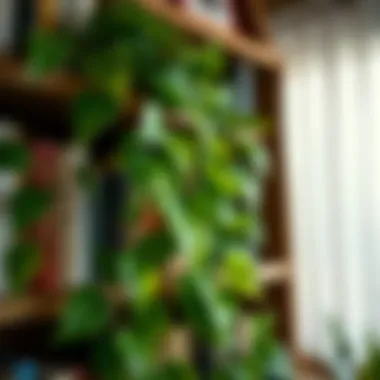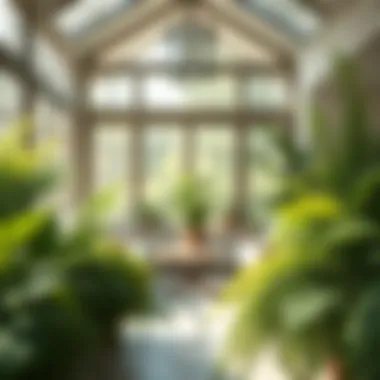Guide to Leafy Indoor Plants for Home Spaces


Intro
Indoor plants have a special place in homes today. They are not just greenery; they add character, warmth, and a touch of nature to our spaces. Leafy indoor plants, in particular, have gained popularity due to their aesthetic contributions and the benefits they provide for our well-being. Their diverse shapes, sizes, and textures can enhance the design of a room while contributing to better air quality and creating a serene atmosphere.
This guide aims to explore various leafy indoor plants, delving into their unique characteristics, care needs, and origins. Along the way, we will touch on how these plants can complement different interior styles, making them a perfect addition to any home, be it cozy or contemporary. Whether you're a new plant parent or a seasoned green thumb, understanding the ins and outs of these plants can elevate your living environment and refresh your interior decor.
Design Inspirations
Trending Styles
In the realm of interior design, leafy indoor plants have transcended mere decoration; they have become a statement of style. Most homeowners today want spaces that reflect their personalities. Incorporating plants can bridge the gap between nature and design, creating a harmonious balance.
One popular trend is the use of large, leafy plants like the Monstera Deliciosa or the Rubber Plant. They serve as magnificent focal points in open areas or narrow corners. The lush green foliage of these plants can soften the stark lines of modern furniture, creating a more inviting atmosphere.
Additionally, smaller plants like Pothos or Spider plants are perfect for shelves, table tops, or even hanging baskets. Their trailing vines add an organic element to decor while requiring minimal space. Mixing and matching different types of leafy plants can also create a vibrant indoor jungle, playing with height and texture to capture the eye.
Color Palettes
When it comes to selecting leafy indoor plants, understand that the color palette of your home influences which plants will harmonize best with your decor. For instance, if your space sticks to a neutral scheme, like grays and whites, opting for deep green foliage can provide a striking contrast and a sense of depth.
On the other hand, if you lean toward eclectic or colorful settings, consider plants with variegated leaves, like the Croton or the Calathea. Their vivid hues can blend seamlessly, adding richness to your overall design without overwhelming it.
"A touch of nature can transform a dull room into a sanctuary, bridging the modern with the organic."
To sum it up, thoughtful selection and placement of leafy plants not only enhance the visual appeal of any room but also create a mood that resonates with the homeowner’s style. This guide will delve deeper into the care and upkeep of these plants, ensuring you enjoy their beauty and benefits for years to come.
Maintenance and Upkeep
Maintaining leafy indoor plants is essential for keeping them thriving and visually appealing. Here, we’ll discuss key aspects of plant care that can make the difference between a flourishing indoor space and a neglected one.
Seasonal Maintenance Checklist
- Spring: Time for growth – repot if necessary, increase watering, and fertilize to promote healthy new growth.
- Summer: Monitor humidity – many tropical plants love moisture, so consider misting or using a humidifier.
- Fall: Start adjusting watering as growth slows down, and check for pests as windows might be open more often.
- Winter: Reduce watering; many plants go dormant during this period. Ensure they receive enough light!
Cleaning and Organization Tips
- Dust leaves regularly. It helps the plant breathe and absorbs light efficiently.
- Rotate pots periodically to ensure even growth; plants will lean toward light sources.
- Utilize trays beneath pots to catch excess water, keeping surfaces clean and preventing damage.
Prelims to Leafy Indoor Plants
Indoor plants have become a popular staple in contemporary home decor. They do far more than just sit on a table gathering dust. Instead, they breathe life into dull corners, turning an ordinary space into an inviting sanctuary. Understanding the role these leafy wonders play in a home is crucial for any homeowner or interior design enthusiast looking to enhance their living environment.
From the air we breathe to the aesthetic appeal, leafy indoor plants contribute aesthetically and practically. They act as natural air filters, helping to remove pollutants and toxins while simultaneously increasing the oxygen levels in our homes. The benefits of bringing the outdoors inside extend beyond appearance; these plants can effectively reduce stress and provide a sense of calm in our hectic lives. It's no wonder that many individuals are turning to gardening, not only as a hobby but as a lifestyle choice.
The Importance of Indoor Plants in Home Decor
The infusion of indoor plants into home decor can transform a mundane space into a vibrant display of nature. Consider a sunny corner with a towering fiddle leaf fig; it commands attention in a way that a simple piece of artwork cannot. The bold, sculptural shape serves as a striking focal point, drawing the eye and sparking conversation.
Moreover, the variability in plant sizes and colors allows for endless creativity in designing a coherent aesthetic that resonates with individual personality. From the striking leaves of a rubber plant to the delicate beauty of a prayer plant, options abound. Educating oneself on how to use these plants to complement existing decor is paramount for achieving harmony in a room.
Benefits of Keeping Indoor Plants
Keeping leafy indoor plants goes beyond mere decoration; it nurtures a holistic connection with our surroundings.
- Air Purification: Certain plants, like the snake plant, excel in improving air quality by filtering out harmful substances.
- Mood Enhancement: Studies have shown that indoor greenery can elevate mood and productivity, making them ideal companions for work-from-home setups.
- Enhanced Humidity: Plants release moisture into the air, which can help alleviate dry skin and respiratory issues associated with indoor heating.
- Aesthetic Diversity: The sheer variety in foliage and form promotes creativity and uniqueness in interior design. Whether you prefer lush tropical plants or sleek succulents, the choices can cater to any style.
In brief, the appeal of indoor plants dwells in their multi-faceted contributions to both the home and well-being. By incorporating them thoughtfully, individuals can create spaces that aren't just visually appealing but also nurturing for the body and mind.
"Indoor plants are not typically a luxury; they are an essential part of a healthy living space."
This notion reiterates the significance of understanding how plant choices can positively impact home environments, driving the conversation about the potential of leafy companions to enhance our everyday experiences. In the sections that follow, we will explore various popular and lesser-known leafy indoor plant species and their specific care requirements.
Popular Leafy Indoor Plants
In the realm of indoor gardening, leafy plants reign supreme, capturing the hearts and homes of many. Their importance lies not only in their visual appeal but also in the numerous benefits they offer. Homeowners and design enthusiasts alike can turn any space from bland to captivating with the right combination of foliage.
Indoor plants such as the Fiddle Leaf Fig, Rubber Plant, and Pothos have gained popularity because they merge aesthetics with practicality. These plants serve as statement pieces that can elevate the ambiance of a room, making them essential for those looking to enhance their indoor environments. Moreover, popular leafy indoor plants often come with manageable care requirements, making them suitable for a wide array of skill levels.
Fiddle Leaf Fig
The Fiddle Leaf Fig is often considered a poster child for indoor plants due to its large, violin-shaped leaves. These plants can reach impressive heights, making them a fantastic choice for filling empty corners or adding drama to an open space. One notable feature is the way its leaves can create a striking focal point, naturally drawing the eye. However, they do require specific care including bright, indirect light, and a careful watering schedule. Over-watering can lead to root rot, while low light can discourage leaf growth. Ensuring the right balance may feel like walking a tightrope; yet, the reward is a lush, vibrant addition to your home.
Rubber Plant
The Rubber Plant, with its glossy, dark green leaves, is another favorite among plant lovers. This robust plant can tolerate lower light conditions and prefers a warm, humid environment. The aesthetic appeal of the Rubber Plant is enhanced by its ability to grow tall and bushy with the right care. Additionally, it’s known for air-purifying qualities, which is an added bonus for health-conscious homeowners. When considering placement, opt for a spot that receives plenty of indirect sunlight. A little tip: rotating the plant periodically encourages even growth on all sides.


Pothos
Pothos, often dubbed the "Money Plant," is perhaps one of the easiest leafy indoor plants to grow, making it a popular choice for beginners. Its heart-shaped leaves cascade beautifully, creating a delightful display when hung in pots or placed on high shelves. Pothos thrives in various lighting conditions—from low light to bright spots—making it incredibly adaptable. Regular watering is key, but this resilient plant can bounce back from neglect, making it nearly foolproof. Those seeking a no-fuss aesthetic should definitely consider incorporating this plant into their collection.
Snake Plant
The Snake Plant, also known as Sansevieria, is famous for its resilience. Its upright, sword-like leaves add a minimalist touch to any décor. One of its most appealing traits is its ability to thrive on neglect. This plant can tolerate lower light levels and doesn’t require frequent watering, thanks to its succulent-like characteristics. Moreover, the Snake Plant is known for its capability to filter toxins from indoor air. While it may not produce flowers, the structure and style it brings make up for it, adding a fresh breath of life to any corner.
ZZ Plant
The ZZ Plant is a true standout due to its striking, glossy leaves. This tough plant flourishes even in less-than-ideal conditions, making it a great option for those who travel frequently or lack a green thumb. ZZ Plants can thrive in low light and require very little water, often growing from neglect. Their unique leaf structure creates an interesting visual element which integrates well into various design styles, from modern to rustic. Perfect for busy homeowners, it's a perfect complement for any space that needs a touch of elegance with virtually no maintenance aside from occasional dusting.
Lesser-Known Leafy Indoor Plants
In the world of indoor gardening, most folks tend to gravitate towards the usual suspects such as pothos or fiddle leaf figs. However, there’s a whole universe of lesser-known leafy indoor plants that deserve the spotlight. These plants often pack a punch—whether through unique aesthetics, care requirements, or benefits to your living space. When we broaden the scope beyond the popular varieties, we open ourselves up to a realm of diversity that not only enhances the decor but also contributes to improved air quality and mental well-being.
Chinese Evergreen
The Chinese Evergreen, scientifically known as Aglaonema, is a charismatic addition to any home. These plants boast stunning variegated leaves, which can come in shades of green, silver, and even deep maroon. They are particularly ideal for beginners as they thrive in low-light conditions and are quite forgiving of neglect. It’s not just their looks that attract; they are known for filtering toxins from the air, contributing to a healthier living environment.
Care Tips for Chinese Evergreen:
- Light: Preferably low to medium indirect sunlight.
- Water: Allow the top inch of soil to dry out between waterings. Too much moisture can lead to root rot.
- Humidity: They enjoy humidity but can adapt.
Tip: If the leaves start to lose their vibrancy, consider repositioning the plant for better light exposure.
Peperomia
Next on our list is Peperomia, a funky little plant that's just as charming as its name suggests. With over 1,000 species, these plants come in various forms and colors, making them an excellent choice for collectors. They're characterized by their compact growth style and thick, fleshy leaves, which store water. This makes them drought-resistant, which is a boon for those who sometimes forget to water regularly.
Care Tips for Peperomia:
- Light: Bright, indirect sunlight is best. They can tolerate lower light but will not flourish as well.
- Water: Water when the top layer of soil feels dry; usually every 1-2 weeks.
- Humidity: They thrive in average humidity; no need for a humidifier.
Prayer Plant
The Prayer Plant, known scientifically as Maranta leuconeura, is a true conversation starter. At night, the leaves fold up as if in prayer, hence the name. With its striking leaf patterns and colors ranging from green to red and purple, it adds a splash of vibrancy to any space. It is also beneficial for indoor environments as it helps to improve air quality.
Care Tips for Prayer Plant:
- Light: Prefers bright, indirect light, but avoid direct sunlight, which can scorch the leaves.
- Water: Keep the soil evenly moist; they appreciate a little more attention in terms of watering compared to others.
- Humidity: Enjoys high humidity—consider using a pebble tray to maintain moisture.
Calathea
Considered the diva of houseplants, Calathea is not just good-looking but also interesting in its needs. They boast dramatic foliage that varies in size and patterns, captivating anyone who steps into the room. Calatheas are sensitive to light conditions, which is unusual compared to other houseplants, making it essential to know how to cater to their requirements.
Care Tips for Calathea:
- Light: Loves bright, indirect sunlight.
- Water: Maintain consistent moisture but don’t let them sit in water. Over-watering leads to droopy leaves.
- Humidity: High humidity is crucial for them—they'll thrive in a bathroom or kitchen setting.
In sum, lesser-known leafy indoor plants like Chinese Evergreen, Peperomia, Prayer Plant, and Calathea offer homeowners and interior design enthusiasts a chance to experiment with unique aesthetics while enhancing their living spaces. Their distinct qualities can truly elevate any indoor environment, lending both beauty and health benefits. By incorporating them into your home, you're not just filling a space with greenery; you're also embracing a more varied and enriching indoor plant experience.
For more information on indoor plants, you can check resources like Wikipedia or Britannica.
Categories of Leafy Indoor Plants
Understanding the different categories of leafy indoor plants is essential for anyone looking to enhance their interior spaces. Each category caters to specific conditions and aesthetic preferences, making it easier for homeowners and gardening enthusiasts alike to choose plants that thrive in their unique environments. This section will break down these categories, focusing on how they can positively impact your home decor while aligning with your lifestyle.
Plants for Low Light Conditions
Some environments don't boast plentiful sunlight, yet that doesn't mean you can’t incorporate lush greenery into these spaces. The following plants flourish in lower light situations, offering both beauty and resilience.
Snake Plant
The Snake Plant, or Sansevieria, has become a staple in many homes for good reason. One of its standout aspects is its ability to survive in low light and neglect. With its striking upright leaves that often feature a mix of green and yellow edges, it brings an architectural flair to any room. A beneficial choice for this article, the Snake Plant also has air-purifying qualities, filtering toxins from the air.
However, while these plants are hardy, they do have their quirks. Over-watering is a common pitfall; their need for minimal moisture can easily lead to root rot if you are not careful.
ZZ Plant
The ZZ Plant, scientifically known as Zamioculcas zamiifolia, is another option that can thrive with little light. Its waxy, dark green leaves not only draw attention but are also incredibly easy to maintain. This plant's adaptability to varying humidity levels makes it a popular choice among busy homeowners who may not have a green thumb.
While the ZZ Plant is nearly foolproof, it doesn't do well in overly bright light. Use it in spaces where indirect sunlight dominates to keep it thriving.
Chinese Evergreen


The Chinese Evergreen, or Aglaonema, offers remarkable variability in its leaf patterns and colors, from deep greens to striking whites and pinks. This plant is well-suited for low light areas and brings a splash of color that can liven up a dull corner. Its hardiness under various conditions makes it a favorite among indoor plant aficionados.
Despite being quite tolerant, it’s essential to monitor humidity levels since dry air can cause the edges of leaves to brown. Regularly checking the moisture content of the soil will keep this beauty lush and vibrant.
Plants for Bright Direct Light
For those lucky enough to have spaces filled with sunlight, the following plants can truly shine:
Fiddle Leaf Fig
The Fiddle Leaf Fig, known scientifically as Ficus lyrata, stands tall as a popular choice for light-filled spaces. Its broad, violin-shaped leaves create a dramatic impact, often becoming focal points in modern decor.
This plant demands bright, indirect light, which encourages its characteristic lush growth. While it’s visually stunning, a note of caution: the Fiddle Leaf Fig can be somewhat finicky about its conditions, requiring a careful watering schedule and humidity levels to really thrive.
Rubber Plant
The Rubber Plant, or Ficus elastica, is distinguished by its dark green, glossy leaves. It complements a sunnier spot splendidly, but its versatility also allows it to adapt to lower light if necessary. This plant is celebrated not just for its aesthetic appeal but also for its ease of care.
One of the drawbacks is that it might grow too large for small spaces, so you will need to provide enough room for its potential growth. Regular pruning can help keep this plant manageable while still looking vibrant and healthy.
Plants for Humid Environments
Certain plants within this category thrive in humidity-rich spaces, such as bathrooms and kitchens:
Calathea
Calathea, often referred to as the prayer plant due to its unique leaf movements throughout the day, is a sight to behold. Its intricate patterns and colors make it a luxe addition to any room. Calathea loves humidity, making it perfect for environments where moisture is plentiful.
However, this preference can be a double-edged sword; if your home is too dry, the edges of the leaves can crisp up, requiring more attention to ensure it remains hydrated.
Prayer Plant
The Prayer Plant, or Maranta, is not just visually stunning with its vibrant leaf patterns and unique folding at night, but it’s also charming in its care requirements. This plant prefers low to medium light and thrives in humid conditions. Its delicate nature in needing moisture makes it a great indicator plant, as it will alert you when conditions are not ideal.
While beautiful, it can be susceptible to pests like spider mites, especially in dry conditions, so regular monitoring is necessary.
This segment not only identifies suitable choices for specific lighting and humidity conditions but highlights how these plants contribute significantly to the indoor atmosphere, enriching both the aesthetic and health aspects of living spaces. Remember that proper selection based on these categories will help you flourish as a plant keeper.
Plant Care Requirements
Taking care of indoor plants isn't just about watering them once in a while. It's a thoughtful process that can make all the difference in how your leafy companions thrive in your home. Plant care requirements serve as the backbone of indoor gardening, determining the health and longevity of your greenery. The more you know about their specific needs, the better equipped you'll be to nurture them effectively, ensuring they remain vibrant and add beauty to your space.
Here we explore the essential aspects of plant care: watering, soil and fertilization, and humidity and temperature. Each element plays a critical role in the overall health of your plants, as they all interact with one another in fascinating ways. Understanding these elements not only enhances your gardening skills but helps you create a welcoming environment in your home.
Watering Guidelines
Watering plants might seem like a simple task, but it’s far more nuanced. Each plant variety has its unique watering needs, shaped by its native habitat and physiological traits. Here's what to keep in mind:
- Observation is key: Before grabbing the watering can, take a good look at your plant. Is the soil dry several inches down? Are the leaves looking a bit droopy? These can be signs that your plant might need a drink.
- Frequency varies: In general, it's better to underwater than overwater. For example, snake plants and ZZ plants, known for their drought tolerance, can go weeks without water, while leafy tropicals like the fiddle leaf fig may need more regular hydration.
- Technique matters: When you do water, do it thoroughly. Aim to moisten the whole pot, allowing excess water to drain out. This promotes strong root growth and prevents root rot, which is a common pitfall in indoor gardening.
"Too much water can lead to unhappy plants—think carefully about how much you pour!"
Soil and Fertilization
Not all soil is created equal. Just like people, plants need their nutrients, and the right soil mix can greatly impact their growth.
- Choosing the right soil: Look for a potting mix that suits your plant's needs. Cactus mixes work great for succulents, while a rich, organic mix will benefit leafy greens like the rubber plant.
- Fertilization habits: During the growing season, which usually spans from spring to early fall, feeding your plants every few weeks can encourage lush growth. Organic options like compost tea or seaweed extract can be excellent choices.
- Signs of nutrient deficiency: Yellowing leaves, stunted growth, or weak stems may signal that it’s time to reevaluate your fertilization routine. Watching out for these signs can help you catch problems early.
Humidity and Temperature Needs
Creating the right atmosphere for your plants goes beyond just light; humidity and temperature also play a critical role.
- Humidity levels: Most leafy indoor plants prefer humidity levels around 40-60%. For instance, the calathea likes it on the more humid side. In dry homes, consider using a humidifier or placing water trays near plants to increase the moisture in the air.
- Temperature control: Most indoor plants thrive in temperatures between 65°F to 75°F. Variations above or below this range can stress your plants, leading to poor health.
- Draft avoidance: Watch out for cold drafts or hot air blasts from heaters. Sudden temperature changes can lead to shock, resulting in lost leaves or worse.
By honing in on these care requirements for your plants, you’ll not only keep them breathing but also ensure they contribute positively to your indoor spaces. From the correct watering habits to understanding the nuances of soil fertility and maintaining ideal humidity and temperature, each step is integral to cultivating healthy, happy leafy companions.
Aesthetic Arrangement of Indoor Plants
The arrangement of leafy indoor plants goes beyond mere decorative placements; it lays the foundation for a living space that feels more vibrant and inviting. Thoughtful arrangements can highlight the unique features of each plant, create a sense of harmony, and influence the flow of energy throughout a room. In this section, we will dive into three main aspects: choosing the right pots, grouping plants for visual impact, and incorporating plants into home design. Each of these elements contributes to not just aesthetics, but also to an overall ambience that can transform everyday spaces into thriving sanctuaries.
Choosing the Right Pots
The pot you select for your indoor plants is so much more than a functional necessity. It serves as a statement piece that can accentuate the beauty of a plant while contributing to the overall design of the room. When choosing pots, consider the material, color, and shape.
- Material Matters: Terracotta pots not only provide excellent aeration but also give a rustic touch, while ceramic pots may offer vibrant colors and intricate patterns that inject a dash of personality into your space.
- Color Coordination: Use pots that complement the color scheme of your room. For instance, sleek white pots can enhance minimalist decor, while bold hues can serve as focal points in more eclectic spaces.
- Shape and Size: A tall, narrow pot can draw the eye upwards, making a room feel more spacious. In contrast, wider pots work well for low-growing plants, creating a sense of stability.


Crafting a balanced look is vital. Think about the heights and shapes of your plants, and don't be afraid to mix and match different pot styles to create a dynamic visual landscape.
Grouping Plants for Visual Impact
Grouping plants can amplify their visual impact, turning a collection into an artistic display. This technique is centered on the concept of arrangement – how plants complement each other in size, shape, and color.
- Levels and Layers: Arrange plants in varying heights. A tall Snake Plant can stand proudly beside a cascading Pothos, creating a layered effect that draws the eye from the ground up.
- Themed Groupings: Consider creating thematic groupings. For instance, a tropical corner with a Fiddle Leaf Fig and a Rubber Plant can evoke a serene jungle vibe, while succulents can create a minimalist desert-inspired setting.
- Using Trays or Shelves: Elevating plants on a tray or a tiered shelf allows you to take advantage of vertical space. This can enhance visibility and add depth to your design.
Balancing these elements is essential. When all is said and done, your groupings should feel natural rather than forced – like a well-curated gallery rather than a cluttered garden.
Incorporating Plants into Home Design
Plants should never feel like an afterthought in home design. Instead, they ought to be an integral part of your living space. When done correctly, leafy indoor plants can complement and enhance various design styles.
- Focusing on Focal Points: Position larger plants at strategic locations, such as a living room corner or near a window, where they'll naturally draw attention.
- Using Plants as Room Dividers: Open floor plans can benefit from strategic plant arrangements acting as dividers. Tall plants can create a sense of separation between spaces without compromising light or airflow.
- Blending with Decor: Ensure that your plant choices resonate with your existing decor. A Scandinavian-style home can beautifully showcase minimalistic pots, while a bohemian space might thrive on an eclectic mix of colors and textures.
The right use of leafy indoor plants can turn a house into a home, simply by fostering a connection between the interior and nature.
In summary, the aesthetic arrangement of indoor plants is not merely about beauty; it's about creating environments that soothe the spirit and kindle creativity. By choosing the right pots, thoughtfully grouping your plants, and integrating them into your home’s overall design, you can curate a space that is not just visually pleasing but also a true reflection of your personality and lifestyle.
Common Pests and Diseases
Maintaining the health of leafy indoor plants can be daunting, especially when faced with pests and diseases. Understanding these issues is crucial, not just to safeguard the plants, but also to maintain the integrity of your indoor environment. Affected plants can quickly decline, affecting not just their aesthetic value but also their ability to purify the air. Furthermore, recognizing and addressing these troubles early creates a thriving indoor garden.
Identifying Common Issues
Indoor plants may suffer from a variety of pests such as aphids, spider mites, and mealybugs. These nuisances often go unnoticed until the issue escalates. Here are some telltale signs:
- Yellowing Leaves: When the leaves start losing their green pigment, it could be a sign of pest infestation or nutrient deficiency.
- Sticky Residue: A sticky substance on leaves may indicate aphids or scale insects.
- Webbing: Fine web-like structures on or around the plant usually hint at spider mites.
- Wilting or Dropping Leaves: This can signal stress from pests or diseases.
Identifying these symptoms promptly can save your plants from severe deterioration. The sooner you act, the better the chances of restoration.
Preventative Measures
Prevention is often your best defense against pests and diseases. Here are some practical steps you can take:
- Regular Inspection: Make it a habit to closely examine your plants’ leaves and stems for any unusual signs. Early detection is key.
- Clean Environment: Dust and dirt can harbor pests. Wiping down leaves not only helps in eliminating dust but also provides a close-up view for potential issues.
- Isolate New Plants: When bringing home a new plant, keep it away from others for a couple of weeks to avoid introducing pests.
- Proper Watering: Overwatering can lead to root rot which attracts pests. Ensure the drainage holes are functioning properly.
Incorporating these practices into your plant care routine can significantly minimize the risk of pest encounters.
Nurturing Healthy Plants
Healthy plants are less susceptible to pests and diseases. Adequate care helps in building resilience against infestations:
- Nutritious Soil: Utilizing high-quality potting mix ensures good drainage and nutrients.
- Consistent Watering Schedule: Stick to a regular watering routine appropriate for each plant. Over or under-watering can lead to vulnerabilities.
- Humidity Control: Many indoor plants thrive in humid conditions. Consider using a humidifier or group plants together to maintain that moisture.
- Balanced Fertilization: Feed your plants during their growing seasons, however, be cautious not to over-fertilize, as this can backfire and attract pests.
With attentive care and preventive strategies, your leafy indoor plants can flourish, contributing to the overall charm and air quality of your living spaces.
"A little vigilance today can save your plants tomorrow."
For further reading on respected plant care strategies, visit Wikipedia or browse recommendations on pest control at Reddit.
Enhancing Well-Being with Indoor Plants
The incorporation of leafy indoor plants into our living spaces does more than just beautify the environment; it offers profound benefits that can enhance overall well-being. These plants serve as natural air purifiers, reduce stress levels, and can even foster deeper connections within our homes and communities. When we fill our spaces with greenery, we create not just a home but a sanctuary of tranquility and health.
Psychological Benefits
Psychologically speaking, having indoor plants can work wonders for our mental health. They help cultivate a calming atmosphere. Studies have shown that the presence of greenery can lower cortisol levels, which is the hormone associated with stress. Just picture a long day at work; you walk through your door, and there it is—a flourishing Pothos hanging beautifully in the corner, instantly lifting your spirits.
- Boosting Mood: Indoor plants thrive on attention and care, which can provide a sense of purpose. Taking time to tend to them gives a boost to your mood. This is particularly beneficial for individuals prone to anxiety and depression.
- Increased Creativity: It’s been suggested that living in green spaces can inspire creativity. When your environment reflects life and color, fresh ideas spring forth like daisies in the spring.
- Mindfulness Practice: Engaging with your plants can also act as a form of mindfulness. Watering, pruning, or simply observing their growth encourages you to stay present and can serve as a healthy distraction from daily life.
Air Quality Improvement
In addition to psychological benefits, leafy indoor plants greatly contribute to the improvement of air quality. Many common houseplants can absorb toxins and release oxygen, thereby creating a healthier living environment. Here’s how:
- Removal of Toxins: Plants like the Snake Plant and Rubber Plant have been documented to filter out common indoor pollutants such as formaldehyde and benzene. With these plants around, your air can be as fresh as a morning breeze.
- Humidity Regulation: Plants release moisture into the air through a process called transpiration. This can naturally humidify dry indoor air, making it much more comfortable, especially during winter months when heating can suck out moisture.
- Enhanced Oxygen Levels: Certain leafy plants can increase oxygen levels in enclosed spaces. For instance, the Peace Lily is not only easy on the eyes, it can help enhance the overall breathability in your home.
"Indoor plants are not just pretty additions; they are a vital part of creating an atmosphere that nourishes both our mind and body."
Ultimately, incorporating leafy indoor plants is an investment in your well-being. From the calming effect they impart to their role in purifying the air, these vibrant green companions can significantly elevate our quality of life. By fostering awareness of the myriad benefits they bring, both psychologically and environmentally, homeowners are better equipped to choose plants that resonate with their lifestyle and enhance their home decor.
End
Bringing leafy indoor plants into your space is more than just a trend; it’s a testament to modern living that values both aesthetics and wellness. This article has illuminated various aspects of indoor plants, from the popular choices like Fiddle Leaf Figs to the more obscure yet equally captivating varieties like Calathea. Understanding the importance of these plants in home decor extends beyond their mere visual appeal. They embody a blend of nature and interior design, playing a vital role in creating an inviting atmosphere.
One of the core benefits discussed is the psychological uplift these plants provide. Research shows that having greenery around us can significantly lower stress levels and promote a sense of calm. This speaks volumes about their value in residential or personal spaces, where peace of mind is paramount. Additionally, the positive impact on air quality cannot be overstated. Certain plants have shown the ability to filter pollutants and toxins, thus enhancing the overall breathing experience in our homes.
Future Trends in Indoor Gardening
As we look ahead, the realm of indoor gardening is poised for exciting changes. The rise of technology in this field is nothing short of remarkable. Smart planters that monitor soil moisture and send reminders to water your plants are becoming more common. Such technological advancements make plant care simple and accessible, even for those who might not consider themselves green thumbs.
Moreover, there’s a growing trend of integrating indoor gardening with modern design. Homeowners are more focused on how plants can fit seamlessly into their interiors. Biophilic design, which emphasizes the connection between nature and architecture, is grabbing attention. It encourages the incorporation of living elements into environments to enhance well-being. Expect to see more homes featuring vertical gardens, living walls, and plants as part of artistic installations.







